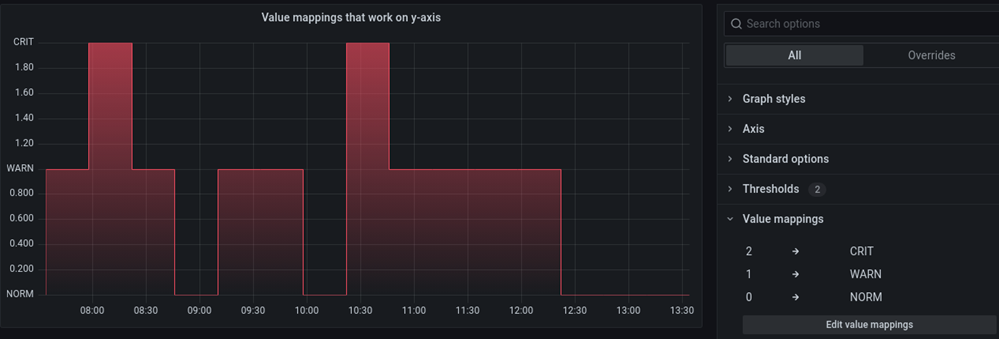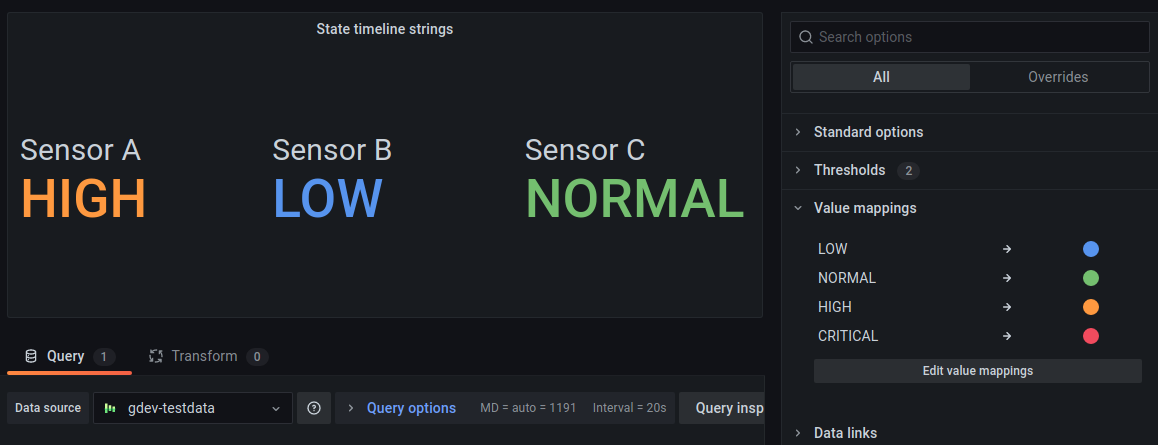Important: This documentation is about an older version. It's relevant only to the release noted, many of the features and functions have been updated or replaced. Please view the current version.
Configure value mappings
In addition to field overrides, value mapping is a technique that you can use to change the visual treatment of data that appears in a visualization.
Values mapped using value mappings bypass the unit formatting. This means that a text value mapped to a numerical value is not formatted using the configured unit.

If value mappings are present in a panel, then Grafana displays a summary in the side pane of the panel editor.
Types of value mappings
Note
The new value mappings are not compatible with some visualizations, such as Graph (old), Text, and Heatmap.
Grafana supports the following value mappings:
- Value: Maps text values to a color or different display text. For example, you can configure a value mapping so that all instances of the value
10appear as Perfection! rather than the number. - Range: Maps numerical ranges to a display text and color. For example, if a value is within a certain range, you can configure a range value mapping to display Low or High rather than the number.
- Regex: Maps regular expressions to replacement text and a color. For example, if a value is
www.example.com, you can configure a regex value mapping so that Grafana displays www and truncates the domain. - Special Maps special values like
Null,NaN(not a number), and boolean values liketrueandfalseto a display text and color. For example, you can configure a special value mapping so thatnullvalues appear as N/A.
You can also use the dots on the left to drag and reorder value mappings in the list.
Examples
Refer to the following examples to learn more about value mapping.
Time series example
The following image shows a time series visualization with value mappings. Value mapping colors are not applied to this visualization, but the display text is shown on the axis.

Stat example
The following image shows a Stat visualization with value mappings and text colors applied. You can hide the sparkline so it doesn’t interfere with the values.

Bar gauge example
The following image shows a bar gauge visualization with value mappings. The value mapping colors are applied to the text, but not to the gauges.

Table example
The following image shows a table visualization with value mappings. If you want value mapping colors displayed on the table, then set the cell display mode to Color text or Color background.

Map a value
Map a value when you want to format a single value.
- Open a panel for which you want to map a value.
- In panel display options, locate the Value mappings section and click Add value mappings.
- Click Add a new mapping and then select Value.
- Enter the value for Grafana to match.
- (Optional) Enter display text.
- (Optional) Set the color.
- Click Update to save the value mapping.

Map a range
Map a range of values when you want to format multiple, continuous values.
- Edit the panel for which you want to map a range of values.
- In panel display options, in the Value mappings section, click Add value mappings.
- Click Add a new mapping and then select Range.
- Enter the beginning and ending values in the range for Grafana to match.
- (Optional) Enter display text.
- (Optional) Set the color.
- Click Update to save the value mapping.

Map a regular expression
Map a regular expression when you want to format the text and color of a regular expression value.
- Edit the panel for which you want to map a regular expression.
- In the Value mappings section of the panel display options, click Add value mappings.
- Click Add a new mapping and then select Regex.
- Enter the regular expression pattern for Grafana to match.
- (Optional) Enter display text.
- (Optional) Set the color.
- Click Update to save the value mapping.
Map a special value
Map a special value when you want to format uncommon, boolean, or empty values.
- Edit the panel for which you want to map a special value.
- In panel display options, locate the Value mappings section and click Add value mappings.
- Click Add a new mapping and then select Special.
- Select the special value for Grafana to match.
- (Optional) Enter display text.
- (Optional) Set the color.
- Click Update to save the value mapping.

Edit a value mapping
You can edit a value mapping at any time.
- Edit the panel that contains the value mapping you want to edit.
- In the panel display options, in the Value mappings section, click Edit value mappings.
- Make the changes and click Update.



